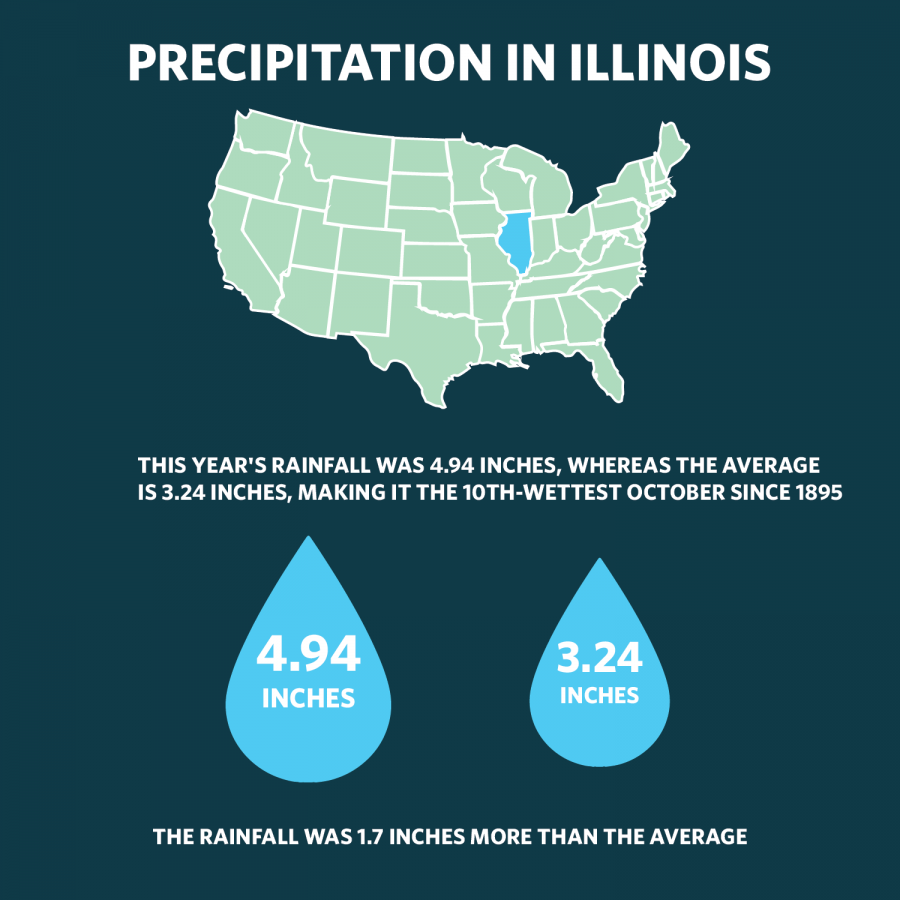October was 10th wettest since 1895
Source: Illinois News Bureau
Nov 16, 2017
Last updated on Nov. 20, 2017 at 08:22 p.m.
Since 1895, the state of Illinois has experienced an October rainfall of this excessive amount only 10 other times. The average precipitation in Illinois for this October was 4.94 inches, which is 1.70 inches above normal.
University of Illinois’ Jim Angel conducted this research through the Illinois State Water Survey, which is connected to the Prairie Research Institute at the University.
Angel, Illinois climatologist, said the precipitation occurred mostly in the Chicago area and at a lesser amount in central and southern Illinois.
Angel said this has caused a reoccurring flooding problem in the Chicago area due to the way the city and towns are constructed.
Get The Daily Illini in your inbox!
“This has been an ongoing problem in the Chicago area because you not only get rainstorms, but it’s also paved over and there are buildings, so there’s not much place for this water to go,” Angel said.
Glen Ellyn, a town outside Chicago with a population of 28,042, received 15.90 inches of rain this past October, making it the largest monthly total of precipitation.
Seven other sites in Illinois reported seeing more than 1 foot of precipitation in October.
Angel said the reason for this area to receive the most rainfall lies in luck and where the storms happened to hit.
He said that because this heavy rainfall is expected to continue, the Chicago area must better prepare for it.
“We need to think harder about how we manage stormwater and build things in the future,” Angel said.
Recommendations from Angel include investing in more green infrastructure like gardens on roofs, implementing rain gardens to slow down the water and putting permeable pavers in the streets so water can soak in, rather than run off.
Randy Chase, graduate student in LAS, said the heavy rainfall could also be due to the region experiencing a La Niña.
“A La Niña for our region usually means a more wet pattern,” Chase said.
Regarding temperature,October was the 21st-warmest since 1895. With an average temperature of 57.7 degrees, it has been 3.3 degrees above the average, Angel wrote.
“We have seen this increase in precipitation over the past 100 years or so,” Angel said. “Most places have seen an increase of 10-15 percent, and we think this is most likely due to an increase in the temperatures.”
Francina Dominguez, associate professor in the Department of Atmospheric Sciences, said the increased precipitation is expected with the warmer weather Illinois has experienced this month.
“There has been a very consistent tendency in the eastern United States for increases in the intensity and frequency of heavy precipitation events,” Dominguez said.
Dominguez also said she goes into detail with students about events like this and the physical causes of such changes in one of her classes.
Both Chase and Dominguez expressed that natural variability could be a main factor in the cause for heavy precipitation this month.
According to the National Climate Assessment, there has been an increase in the observed change in very heavy precipitation in the Midwest; it has increased by 37 percent from 1958 to 2012.
Across Illinois, temperatures have ranged dramatically, with the first 21 days being 7 degrees above normal and the last 10 days being 7 degrees below normal.
“We are talking about this all the time,” Dominguez said. “We are trying to understand why the hydrologic cycle is changing and what are the potential consequences in the future.”






